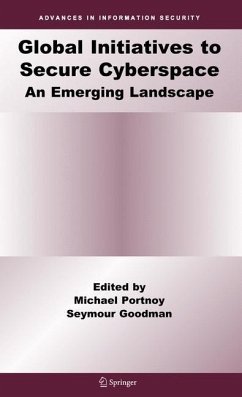The ease of access, relative anonymity, and borderless nature of the Internet has allowed widespread computer-based crime - or cybercrime - to proliferate rapidly. Law enforcement and international security organizations, along with governments and the private sector, have only recently begun to appreciate the scope, severity and transnational nature of this problem. In recent years, organizations have begun to emerge and evolve in a progressively collaborative ecosystem of vested international bodies seeking to address these challenges in unique, innovative ways.
This study attempts to address a series of questions regarding the current state of cyber security. What does the international landscape of cyber security look like today? What are these organizations actually doing? Are they succeeding? What measureable progress has been made in developing a supportive ecosystem of global cyber security? Are these organizations presenting practical, innovative, collaborative, and sustainable solutions to address these issues?
Global Initiatives to Secure Cyberspace: An Emerging Landscape is designed for a professional audience composed of researchers, practitioners and the government, focusing on a secure cyberspace industry. Advanced-level students in computer science will also find this book suitable.
As cyberspace continues to rapidly expand, its infrastructure is now an in- gral part of the world's economy and social structure. Given this increasing int- connectivity and interdependence, what progress has been made in developing an ecosystem of safety and security? This study is the second phase of an initial - tempt to survey and catalog the multitude of emerging organizations promoting global initiatives to secure cyberspace. The authors provide a breakdown and analysis of organizations by type, - cluding international, regional, private-public, and non-governmental organi- tions. Concluding with a discussion of the progress made in recent years, the study explores current trends regarding the effectiveness and scope of coverage provided by these organizations and addresses several questions concerning the overall state of international cyber security. The authors would like to thank Mr. Anthony Rutkowski for generously p- viding his time, guidance, and support. The authors would also like to thank the International Telecommunication Union (ITU) Telecommunication Development Sector (ITU-D) and the United States National Science Foundation (NSF Grant R3772) for partially supporting the research conducted in this study. In addition, the authors would like to thank the Georgia Institute of Technology's Center for International Strategy, Technology, and Policy (CISTP) for assistance in hosting the Cyber Security Organization Catalog, and the Georgia Tech Information Se- rity Center (GTISC) for cooperation and promotion of this study. Table of Contents 1 The International Landscape of Cyber Security . . . . . . . . . . . . . . . . . . . . . . . . . . . . . . . . . . . . . . . . . . . . . 1 2 A Brief History of Global Responses to Cyber Threats . . . . . . . . . . . . . . . . . . . . . . . . . . . . . . . . . .
This study attempts to address a series of questions regarding the current state of cyber security. What does the international landscape of cyber security look like today? What are these organizations actually doing? Are they succeeding? What measureable progress has been made in developing a supportive ecosystem of global cyber security? Are these organizations presenting practical, innovative, collaborative, and sustainable solutions to address these issues?
Global Initiatives to Secure Cyberspace: An Emerging Landscape is designed for a professional audience composed of researchers, practitioners and the government, focusing on a secure cyberspace industry. Advanced-level students in computer science will also find this book suitable.
As cyberspace continues to rapidly expand, its infrastructure is now an in- gral part of the world's economy and social structure. Given this increasing int- connectivity and interdependence, what progress has been made in developing an ecosystem of safety and security? This study is the second phase of an initial - tempt to survey and catalog the multitude of emerging organizations promoting global initiatives to secure cyberspace. The authors provide a breakdown and analysis of organizations by type, - cluding international, regional, private-public, and non-governmental organi- tions. Concluding with a discussion of the progress made in recent years, the study explores current trends regarding the effectiveness and scope of coverage provided by these organizations and addresses several questions concerning the overall state of international cyber security. The authors would like to thank Mr. Anthony Rutkowski for generously p- viding his time, guidance, and support. The authors would also like to thank the International Telecommunication Union (ITU) Telecommunication Development Sector (ITU-D) and the United States National Science Foundation (NSF Grant R3772) for partially supporting the research conducted in this study. In addition, the authors would like to thank the Georgia Institute of Technology's Center for International Strategy, Technology, and Policy (CISTP) for assistance in hosting the Cyber Security Organization Catalog, and the Georgia Tech Information Se- rity Center (GTISC) for cooperation and promotion of this study. Table of Contents 1 The International Landscape of Cyber Security . . . . . . . . . . . . . . . . . . . . . . . . . . . . . . . . . . . . . . . . . . . . . 1 2 A Brief History of Global Responses to Cyber Threats . . . . . . . . . . . . . . . . . . . . . . . . . . . . . . . . . .
From the reviews: "Cybercrime is essentially a transnational crime, with a modus operandi that exploits interstate differences in the capacity to respond to such crimes. ... Readers without a lot of time to spare may find this short book an easy (and useful) read, if used as it deserves to be--as a handbook that informs the reader about current initiatives undertaken by international organizational bodies, regional intergovernmental organizations, and public-private and nongovernmental organizations to combat cybercrime." (Kim-Kwang Raymond Choo, ACM Computing Reviews, June, 2009)








